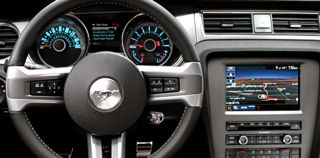Drivers using voice-controlled systems take their eyes off the road more than expected, safety researchers have found. The total “glance time” for some interactive tasks appeared to exceed the federal guidelines for visual-manual interactions by drivers.
 The MIT study delivered a mix of good and bad news: “Both positive features and concerns associated with the use of the voice interface were identified.”
The MIT study delivered a mix of good and bad news: “Both positive features and concerns associated with the use of the voice interface were identified.”
Age seemed to be linked with the challenges of using these interactive dashboard systems: The results suggested that older drivers tended to be more distracted than younger subjects, even adjusting their bodies as if they were in conversation with the interface screen.
Overall, the researchers said, “modern vehicle-control systems (place) demands on the driver’s attention in multiple ways, including visual, manual and auditory senses, among others.”
The Massachusetts Institute of Technology study looked at “perceived workload, physiological arousal, visual attention, and basic driving performance metrics” while subjects performed various tasks using the Ford Sync system. The observations were made under actual highway conditions.
The study’s “researchers actually found that cognitive load … was lower than expected, likely in part because drivers compensated for their use of voice-command systems by slowing down, changing lanes less frequently or increasing the distance to vehicles ahead.
The study looked at “basic entertainment and communications tasks” of controlling the radio by voice, music selection from a connected MP3 device, and voice dialing of a stored phone number.
“Entry of a full street address into a navigation system was of particular interest, since manual entry of addresses into navigation devices while under way is generally recognized as being highly visual-manually demanding,” the researchers said.
The researchers noted that while there had been a number of studies of “experimental Wizard of Oz” voice systems, “only a limited number of reports have addressed production-level embedded vehicle systems.” Many studies were done in driving simulators, they pointed out.
The vehicle of choice was a 2010 Lincoln MKS with factory-installed Ford Sync and Sirius Travel Link. Researchers stressed that their findings were not limited to these interactive systems. (“Other systems employing similar design characteristics are likely to demonstrate demands.”)
Sixty drivers participated, balanced by gender and across the two age groups (20-29 years old and 60-69). They received “extensive training” in use of the voice interface systems before the testing.
The study found that while voice interaction was deemed less demanding than the manual version of the task, it took more time away from full attention to the road. For example, entering an address into the navigation system took about 2 minutes.
This led the researchers to ask: “Is there a point at which an overtly low to moderately demanding task becomes problematic due to length of engagement?”
Also closely connected with the GPS was the issue of “glance time.” “Mean total off-road glance time during the address entry task was 32.8 seconds for the sample as a whole (25.9 seconds for younger adults and 41.7 for older adults).”
That means the address entry task would not meet the National Highway Transportation Safety Administration voluntary guideline of a total 12 seconds with eyes off the road to perform any electronic device task. (The NHTSA released its guidelines in April 2013, and Transportation Secretary Anthony Foxx said in December that they are being revised.)
The older drivers spent more time glancing at the interface than did the younger subjects, and oriented their bodies toward the digital screen.
Still, there was no clear evidence that use of voice control poised a safety threat: “The voice interface studied, although visually and cognitively demanding, did not result in an overt increase in adverse driving events (speed of the vehicle) or control corrections (steering wheel).”
The DOT has said its vehicle-distraction guidelines are voluntary because more research is needed on overall driver distractions; in-vehicle technologies continue to evolve; and there is not enough research specifically addressing built-in vehicle electronics.
The study — “The Effects of a Production Level ‘Voice-Command’ Interface on Driver Behavior: Summary Findings on Reported Workload, Physiology, Visual Attention and Driving Performance” — was co-sponsored by Toyota’s Collaborative Safety Research Center and the Santos Family Foundation. It was released in mid-November.
- Read the dashboard voice-control study (PDF)
- Read more distracted driving research.


Not sure which is the more ridiculous and dangerous vision of the future: the driverless car or the mindless driver. Educate!